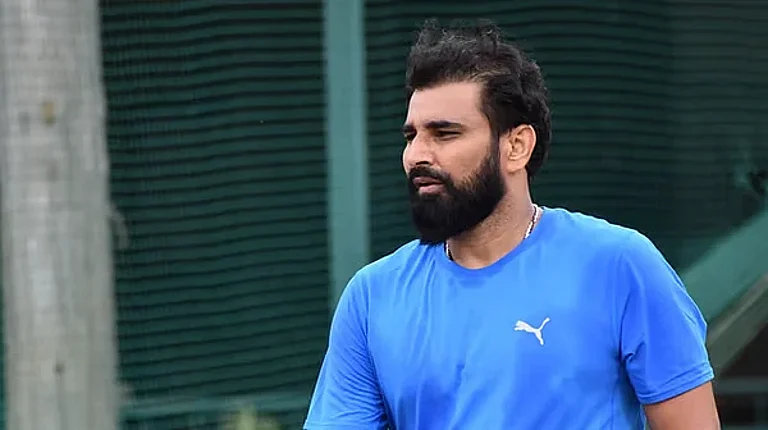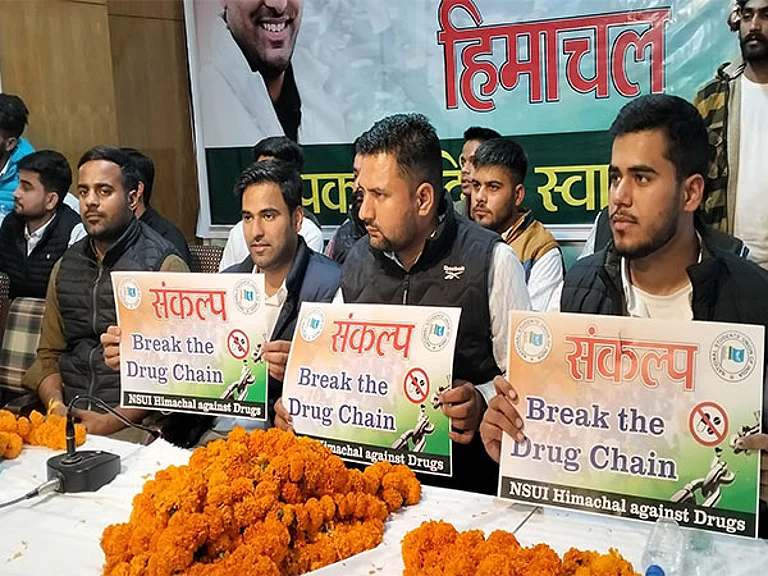It may be no more than an ironic coincidence that I had just finished reading Do Not Say We Have Nothing, a moving narrative woven around a family of Chinese musicians by Madeleine Thien—a compelling fictional critique of the Cultural Revolution, with its crude and class-reductionist understanding of ‘culture’, its indiscreet rejection of everything considered either ‘feudal’ or ‘foreign’, its near-absurd attitude to art and beauty and its unimaginably horrendous and violent attack on some of the best artists of China—when Outlook asked me to write a piece on the radical cultural uprising in Kerala in the 1970s led by the Janakeeya Samskarikavedi (People’s Cultural Forum), linked to the Marxist-Leninist movement. I am by no means making a comparison here; nothing of the sort that happened in China happened in Kerala, though the Cultural Revolution, which later turned out to be little more than a power struggle between two factions of the Chinese Communist Party, was seen with a lot of uncritical admiration by activist comrades, who had no inkling of the ground realities in China. With a slogan like ‘Chinese Chairman, Our Chairman’ and all the intellectual mimicry that automatically followed—like the launching of the cultural publication, Yenan (after Mao’s celebrated Yenan Forum talks) and the entirely mechanical and sectarian view of art and culture that the Marxist-Leninist party upheld—there was little hope that the movement would survive for long. And yet, creativity, as always, proved much stronger than dogma and produced some effective works of art whose impact travelled far beyond party circles.
Looking back, one may well ask, what is the cultural legacy of the 1970s that has survived the recent past, and that proved beyond doubt the mutability, if not the futility, of all the violent revolutions waged in world history? We now know the systems they brought into being proved the very opposite of what the martyrs and revolutionaries had dreamt of and promised the people, almost mirror-images of those they sought to overthrow, whether it was theocratic blindness, autocratic tyranny or capitalist greed.

Clockwise from top left: Ayyappa Paniker, D. Vinayachandran, Civic Chandran and Balachandran Chullikkad
A quick review of the experience of the People’s Cultural Forum in Kerala may not have all the answers to our questions, but may help us make sense of history in these post-truth times, when history has more to do with propaganda—its manufactured images and its manipulation of popular will, what Antonio Gramsci termed ‘consent’—than with truth per se. I do not want to pretend that the experience of Kerala holds true for the whole of India, but it certainly has important lessons for the culture and art of radical movements everywhere. The impact of the movement was felt in Kerala mostly in literature, especially poetry, and theatre, though it did impact other arts like music, painting, sculpture and film. A lot of that influence has vanished, but there are younger writers and artists who have carried the legacy forward in diverse ways and are still helping shape an aesthetics of resistance. Of the younger writers and artists, some acknowledge this relationship, some do not, and some are critical of the social in art in regressive ways and believe in an art that is purely personal and concerned only with the smaller moments of individual existence than with the bigger moments of social or national history—though the present political context is, albeit unconsciously, forcing them to rethink their position vis-a-vis the nation and society.
The relationship between the party and the cultural organisation in Kerala was never smooth. This was natural, considering the demands of a cadre party that was working mostly underground and the nature of cultural practice, which is public and open. The activities of the Cultural Forum, besides the trial of corrupt doctors and officers, spanned a wide gamut in theatre. There were both street plays like those by Civic Chandran and proscenium plays like the adaptation of Brecht’s play based on Gorky’s Mother, Madhu Master’s Padayani, my Shaktan Thampuran, an adaptation of Brecht’s Trial of Lucullus. Baby’s play Nadugeddika—which could be played both on stage and in open public spaces, and had the structure of a tribal ritual of exorcism and a cast consisting mostly of tribal people—was staged across Kerala. Besides, there were campus plays and poetry readings on street corners, maidans and workers’ colonies by poets who had established themselves much before the formation of the Forum, like Kadammanitta Ramakrishnan, Balachandran Chullikad, D.Vinayachandran, K.G. Shankara Pillai and this writer, apart from young poets from Civic Chandran to P. Udayabhanu and campus poets.
This kind of public engagement attracted people and connected with them at a much deeper level than the activities of the party ever could even imagine. This also was probably a cause for tension between the party and the Forum. Again, all artists who collaborated with the Forum did not necessarily subscribe to the views and policies of the party; many of us, for example, were highly critical of alienating and futile strategies like the annihilation of individual exploiters that we thought was no cure for systemic ills but would only prove an impediment. Many of us also collaborated with other broadly leftist cultural organisations, like the Deshabhimani Study Circle led by the CPI(M) and Shasthrasahitya Parishad (Forum for Scientific Writing), run by science and environment enthusiasts, and contributed to mainstream journals irrespective of political predilections.
There were very few women in the party, making it no less patriarchal than other Communist parties. There was little difference in the basic approach, except that the party did not believe in elections, condemned law courts as ‘bourgeois’ and upheld peasant revolution and guerrilla warfare, following the Chinese model. It was as class-reductionist as other parties and did not take caste as a defining divisive category in Indian society. But the Cultural Forum and its mouthpiece Prerana (Persuasion), besides little magazines and campus journals that came up during this time, were more open to the questions of gender and caste discrimination, of environment and of unethical medical and bureaucratic practices. We were closer to the more inclusive idea of the ‘subaltern’ than the classical economic category of ‘class’, as ‘subaltern’ meant the social class—in the sense in which Nicos Poulantzas employs the term—which included victims of all kinds of discrimination and exploitation. Our sympathy for the party was mainly due to the moral decadence that we found in the CPI(M) and the sheer sincerity and complete commitment to the cause of the New Democratic Revolution (that was the term) that we found in the new party.
Aesthetically, participants of the Forum were unhappy with the old type of romantic progressive poetry and realistic theatre and art and were closer to modernist modes, especially those emerging in the Third World. (I have elsewhere called it ‘Third World Modernism’, to distinguish it from the solipsistic High Modernism of the early European practitioners). This aesthetic was inspired by offbeat Marxist thinkers like Gramsci—with his idea of ‘hegemony’, which is the indirect and sometimes invisible domination of bourgeois ideology, ‘common sense’ (which is the name often given to regressive thinking) and his critique of popular culture—and an array of broadly leftist thinkers.
There was Mikhail Bakhtin, with his ideas of the ‘carnivalesque’ and of ideology inscribed in language; Walter Benjamin, with his profound notions of the subversive power of modernist texts and urban culture; and Raymond Williams, who found large media creating a climate for the development of capitalism. Althusser’s concept of the relative independence of the superstructure and the relative autonomy of art, which is also shaped by the rules of art as by that of social history, was quite vital to a central debate. Adorno offered a sharp criticism of the ‘culture industry’—the popular film, cassette industry, the romantic and crime novels etc—that ripples with representations of the dominant ideology, and Habermas his understanding of the ‘public sphere’. Roland Barthes came in with his radical semiotic analyses of texts, photographs, films and other modes of communication, which are seldom politically innocent. He also announced “the death of the author”, an event that releases texts, essentially polyphonic entities, and opens them up to a multiplicity of readings. Foucault brought a deep, incisive analysis of the power-knowledge nexus and the genealogy of discourses and institutions and their dividing practices. Derrida evolved his subversive idea of deconstruction, meant to interrogate and undo institutions of power based on discourses of domination. Lacan extended Freud with his understanding of the language of the unconscious. Pierre Macherey wrote of the textual unconscious and symptomatic reading that may question the author’s intentionality. And Deleuze wrote almost liltingly of his preoccupation with ethics. They were later followed by more liberating authors like Jacques Ranciere, Slavoj Zizek, Georgio Agamben, Michel Hardt, Antonio Negri and others, besides several feminist, Black, gay and Dalit thinkers.
The old paradigms of Lukacs and others were almost given up as they were inadequate to explain the works of new writers—from Kafka to Marquez. In fact, we were being consciously or unconsciously closer to Karl Marx than many Marxists in terms of sensibility and later I wrote a long essay on Marx’s ideas of literature, which were seldom sectarian, dogmatic or prescriptive and depended a lot on ways of reading, as is evident from his admiration for classical writers and his critique of many self-proclaimed ‘committed’ writers whose works speak against what they profess. Lenin’s argument in favour of Tolstoy against Plekhanov, who condemned the great Russian writer, is another case in point.
Those were also the years of the African and Latin American ‘boom’ in literature, making works from those continents—by Chinua Achebe, Aime Cesaire, Leopold Senghor, David Diop, Gabriel Marquez, Pablo Neruda, Cesar Vallejo and several others—available in plenty in translations. This, besides the European socialist writers like Paul Eluard, Louis Aragon, Garcia Lorca, Rafel Alberti, Brecht, Martin Enzensberger and Gunter Grass (despite his later revelations), who had abandoned the social-realist model, inspired the new writers of the 1970s in indirect ways. A lot of these works, especially poetry, got translated into Malayalam. I myself published anthologies of African poetry, Latin American poetry, Russian poetry and European poetry in translation, besides selected works of individual poets like Neruda and Brecht. K. Ayyappa Paniker, K.G. Shankara Pillai and Kadammanitta translated radical poets from different parts of the world. I made free adaptations of plays by Brecht, Yeats and Lady Gregory, some of which were staged. Plays like Beckett’s Waiting for Godot was translated by Adoor Gopalakrishnan and Kadammnitta, and Wole Soyinka’s The Swamp Dwellers by R. Narendraprasad, while Ayyappa Paniker translated Jean Toomer’s African-American novel Cane.
Several translations appeared in little magazines and were later published by publishing houses that mushroomed across Kerala during the period. Translations from other Indian languages, like Hindi, Bengali, Marathi, Tamil, Telugu and Kannada—from Dhoomil to P. Lankesh—also appeared in plenty. The ideological setting for the aesthetic revolt was created by workers’ strikes at the national level, like those of the railway workers and dock workers, movements of landless peasants against landlordism in many parts of the country, especially Bengal and Andhra Pradesh, the emerging Dalit Panther movement in Maharashtra—which later spread to various parts of the country—involving writers like Namdeo Dhasal, Narayan Surve, Arjun Dangle and the rise of feminist discourse.
This atmosphere of radicalism and the new aesthetic influenced even older writers who had grown up with the modernist movement, like Ayyappa Paniker and Attoor Ravivarma. There was a parallel movement in fiction, with writers like M. Sukumaran, Pattathuvila Karunakaran, U.P. Jayaraj, P.K. Nanu, C.R. Parameshwaran, N. Prabhakaran and others, articulating a new awareness in fresh forms and styles. Sukumaran wrote allegorical stories that critiqued the State as well as the existing Left, Pattathuvila used trenchant irony to laugh at the system and its pet beliefs, Jayaraj used symbolic and epistolary forms to great effect, Nanu brought his experience of the village and the city to bear on his lyrical narratives, Prabhakaran revisited forgotten chapters of Kerala’s history and Parameshwaran laughed at the decadent Left in the novel Prakritiniyamam (Nature’s Law).
Examining Malayalam literature during the Emergency in an essay titled The Fiddle and the Drum in Indian Author (special issue on the Literature of the Emergency, 1977), I have demonstrated how many of these indirect techniques came in handy for protesting writers during that dark period. In fact, the writers of the ’70s and the modernists of the earlier decade—like O.V. Vijayan, M.P. Narayana Pillai, Anand and Ayyappa Paniker—were the most vocal in resisting the Emergency, as demonstrated by the representative collections of stories and poems of the period brought out by Chintha Publishers. Thadavarakkavithakal (Poems from the Prison, 1977) featured 25 poems by ten poets—including Civic Chandran, P. Udayabhanu, Muhammad Ali, V.K. Prabhakaran and M.M. Somashekharan—all writers of the far Left who were imprisoned during the Emergency. Voices of Emergency, edited by John Oliver Perry, has brought together poets from different Indian languages in English translation, many of whom come from the same political stream. Films like Kabaneenadi Chuvannappol (When the River Kabani Turned Red) directed by P.A. Backer; Harijan, Iniyum Marikkatha Nammal (We Who are Not Yet Dead) and Ore Thooval Pakshikal (Birds of the Same Feather), directed by Ravindran; Amma Ariyan (So That Mother May Know) by John Abraham; Uttarayanam (The Journey towards the North/Throne of Capricorn) by G. Aravindan; Piravi (The Birth) by Shaji Karun and Seshakriya (The Last Rite) by Ravi Alumoodu have been inspired by the turbulence of the times. The Film Society Movement also helped create a new sensibility among film viewers, making popular works by socialist and anti-fascist filmmakers like Eisenstein, Godard, Alain Resnais, Pasolini, Fritz Lang, Zoltan Fabri, Costa-Gavras, Miklos Jancso, Ousman Sembene, Yilmas Guney, Octavio Getino, Fernando Solanas, Glauber Rocha and radical Indian filmmakers from Ritwik Ghatak onwards. Several painters and sculptors who came up during that time, especially those trained in the Baroda School of Art, enriched the scene with works as well as lively debates on art.
I will not go into details about the break-up of the People’s Cultural Forum and the gradual waning of the avant-garde art and literary movement it inspired. Ideological and leadership conflicts within the movement, leading to its fragmentation, disenchantment of some writers and artists with party strategies and attitudes, the new awareness of civil rights and freedoms and the importance of democracy prompted by the Emergency, the substitution of the idea of a one-time revolution by that of ceaseless opposition—what Foucault would call ‘micro-struggles’ or ‘transversal struggles’ and what Hardt and Negri would later see as bio-political resistance, the rise of new social movements that seemed to carry more conviction, events in China and the breakdown of the socialist world, the impact of globalisation, absorption by the mainstream, the exhaustion of initial energies: these could be some of the reasons for it, other than of course the State’s repressive strategies that the middle-class that had led the movement could no more endure.

Clockwise from top left: K.G. Sankara Pillai, Kadammanitta Ramakrishnan, O.V. Vijayan and M.P. Narayana Pillai
But those associated with the movement seldom crossed over to the Right or associated themselves with regressive forces; most continued to be committed to the values that had led them to the movement to begin with and retained the oppositional core in their art or writing. The generation that followed often had a quarrel with the aesthetics of the ’70s and went back to the solipsistic individualism of the ’60s, but I can see a revival of that radical spirit in the generation that is active now in literature and art. I do not mean to say they have anything to do with any political formation as such, but there is palpable disillusionment with the system and a developing critique of it from democratic and egalitarian angles that one finds best articulated in Dalit, women and other avant garde writers, like the poets S. Joseph and P.N. Gopikrishnan, fiction writers like Ambikasutan Mangad, Santhosh Echikkanam, E. Santhosh Kumar, Subhash Chandran, S. Harish, R. Unni and artists like K.M. Madhusudhanan, to name a few, as well as survivors from the ’70s who are now engaged in battling the growing fascist tendencies in the Indian State and society.
The movement of poetry from monologue to dialogue, the democratisation of the poetic idiom, bringing it closer to everyday language, the return of the strong narrative in fiction: all these present trends had been foreshadowed by the writing of the ’70s. The popular slogan of the ’70s, aneethikkethire kalapam cheyyuka (Rebel against injustice), has not ceased to echo in Kerala’s politics as well as culture, as several recent biopolitical struggles outside the confines of established parties and the art and literature of the early decades of the 21st century clearly show. The politics of the ’70s may not have survived, but in certain individuals from that period, as also ineffective later movements, like the present Maoist movement, its ethics—the sense of justice and the egalitarian aspirations that inspired it and its moral indignation—certainly live on in today’s oppositional social movements as well as the avant garde art and culture in Kerala.
***
About Our Little Sister
M.M. Somashekharan
The chill wind, sharp like the needles
pushed into the nails of the thief
in the lockup.
It sobs gently like the love song whistling in
the oak trees in harsh nights.
She felt nothing, her naked body like
the senseless corpse of a counterattack.
Death smiles from the raped lips.
I too mourn silently with her brothers
who work in mines and fields.
Our little sister had fought against
the authority, grown obese, rotten.
“Thousand scapegoats and one wolf”:
that’s the game today.
Her blood, her naked blood,
floods the streets.
Her dead body dragged along the road
goes on growing beyond the streets.
It spreads the foul smell of fear
in the seats of power.
(Translated by K. Satchidanandan)
























